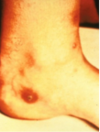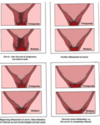GU CM Flashcards
(418 cards)
in women of child bearing age abnormal bleeding is attributed to what UNLESS proven otherwise?
PREGNANCY!!!
what test does every woman of child bearing age get when she is having abnormal bleeding?
PREGNANCY TEST!!!
what two tests should ever patient get when they have abnormal bleeding?
- pregnancy test
- CBC with platelets
when you think of dysmennorhhea and infertility in a 25 year old what should you think of?
endometriosis
dismennorreahh and increasing heavy periods in a 48 year old you should think about what two things?
- endometrial hyperplasia/cancer!!! NEED TO THINK OF THIS
regular periods but a uterus the size of a 10 week pregnancy in a 35 year old should make you think of?
a FIBROID!!!
new onset of bleeding in a 70 year old should make you think of?
cancer until otherwise!!
what is the predominat bacterial of the vaginal flora?
lactobacillis
explain the normal vaginal flora and ph of the vagina?
predominant flora?
vaginal wall cell type?
cells make?
pH?
predominant flora: lactobaciillis….produce lactic acid
vaginal wall: strafified squamous
cells make: glyconuitrient rich environment for microorganisms
pH: 3.5-4.5
what are 7 normal organisms in the vaginal canal other than lactobacillis?
- yeast
- e. coli and other fecal bacteria
- garnerella
- staph, strep
- anaerobes
- trichomonads
what should you watch out for if you see discharge in a young woman?
abuse!
where are bartholins glands? what are their function?
two glands located slightly posterior to the left and right of the opening of the vagina
secrete mucous to lubricate the vaginal opening
1 or 2 drops when sexually aroused
what might cause creamy white discharge in 10 year old girl?
early estrogen secretion
what shoud you think of with white vaginal discharge with intense vaginal itching?
yeast!
what should you think of if post coital spotting in a 70 year old woman?
atrophic vaginitis
what should you think about with intense vulvar itiching in a 60 year old?
lichen sclerosis
what should you think of with a asymptomatic mass at the introitus? 2
- bartholin cyst
- relaxation issue
dependent on age as to what to think about!
stress urinary incontinence
who is this common in?
why does it occur?
explain the pressure differences?
what actions might bring this on?
what are 3 things that could cause this in a person?
common problem in women of all ages and results from weakness or disruption in the pelvic floor muscles leading to poor support of the vesicourethral sphincters
usually: the i_ntraurethral pressure is greater than the intravesicular pressure_ which is called the urethral closure pressure
if i_ntra-abdominal pressure increases_ from things like coughing, laughing, or sneezing and the pressure isn’t equally distributed to the urethra then incontinence occurs
causes of decreased muscle tone: aging, child birth, surgical procedures
urge urinary incontinence
what does the pt feel?
what is this associated with?
what is the definition of this?
what are 2 contributing factors?
3 symptoms?
overactive, nocturia, urinary frequency, detrusor overactivity
loss of urine associated with strong desire to void URGENCY, often associated with overactive bladder
definition: urgency, frequency with or without incontinence in the absence of UTI or obvious pathology
Two contributing factors to overactive bladder:
- CNS and neural control of bladder sensation and emptying, ex: stroke, Parkinsons, MS
- smooth muscle of the bladder itself (myogenic)
incomplete emptying “overflow” urinary incontinence
what are 7 signs of this?
what are two causes?
what are 2 causes in women?
what are 2 causes in men?
intravesical pressure exceeds the maximal urethral pressure because of bladder distension
dribbling, weak urinary stream, frequency, and nocturia, hesitancy, frequency, nocturia, nocturnal enuresis (bedwetting), detrusor underactivity or bladder outlet obstruction
women causes: uterine prolapse, previous incontinence surgery
men: most common is enlarged prostate gland
what are the 3 PE tests you want to do with someone with urinary incontinence?
what are the 4 workup tests you would do?
PE:
- pelvic exam
- digital rectal exam (masses, prostate)
- neuro exam if sudden loss (think cauda equina)
Workup:
- urinalysis
- prostate specific antigen
- post void bladder scan
- urology consult
although urinary incontince tx is dependent on the type, what are 5 tx options you could consider?
- fluid management
- timed voiding
- bladder retraining
- keagle/pelvic floor exercises
- surgical intervention
- pessaries to hold uterus up
- decrease caffine/alchohol
- (urge) anticholinergics
(oxybutynin, possibly tricyclic antidepressant)
Nephrolithiasis
what are the two things you need for the formation of crystals?
what are four risk factors that allows this to happen?
what are the four types of stones?
formation is dependent on supersaturation and an environment that allows the stone to grow!
supersaturation risk:
heredity- cystinuria SLC3A1/SLC7A9
environmental
diet
obesity
four types of stones:
- calcium oxalate
- struvite
- uric acid
- cystine

nephrolathiasis
struvite stone
what 2 things is this associated with?
4 bacteria?
can you pass them?
when do they get bigger?
3 tx options?
“staghorn” stones that always associated with UTI and alkaline urine
- produced by UTI with urease producing bacteria
- proteus, klebsiella, pseudomonas, enterobacter
- made of magnesium ammonium
- usually too large to pass and require lithotripsy or surgical removal
- they enlarge as the bacterial count increases
Tx:
- prevent UTIs
- lithrotripsy
- surgical removal





























































































